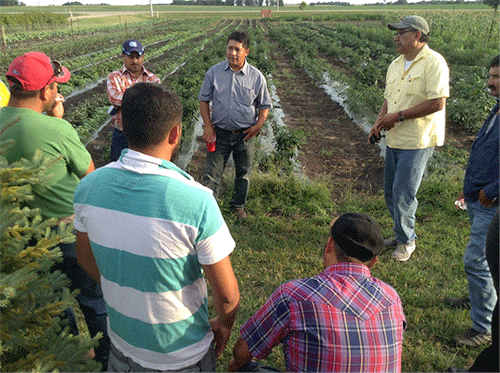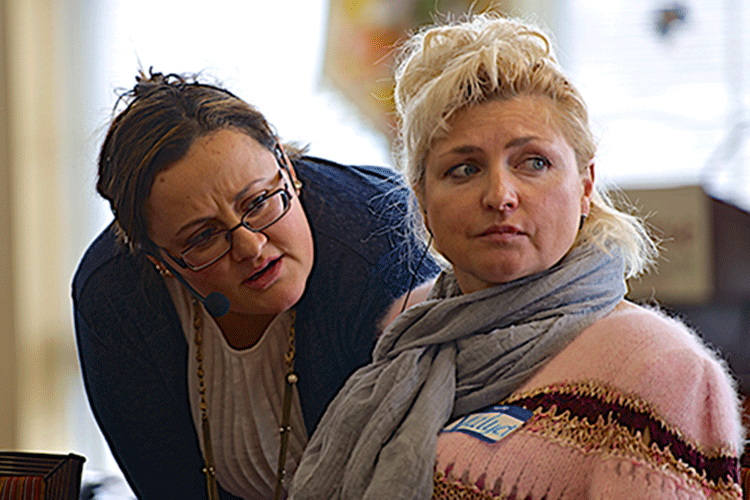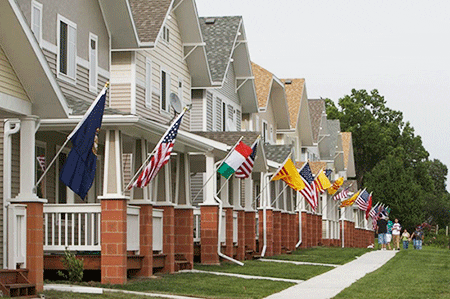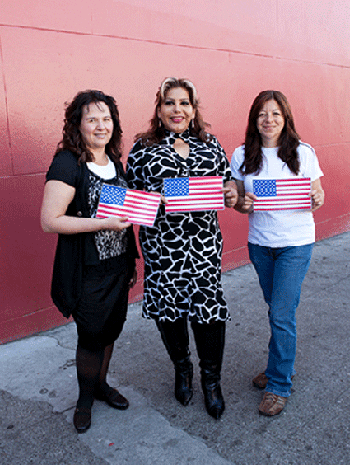The years he spent in a Nepalese refugee camp with his parents, two brothers, and a sister were just the precursor to Dom Acharya’s long journey of migration and assimilation to life in Rust Belt America.
Acharya and his family are Bhutanese refugees who came to Erie, Penn., in 2006 after years of being herded and shuffled about in camps during protracted ethnic clashes between Nepal and Bhutan in the 1990s. Acharya’s family was one of the first to resettle in the Great Lakes city, where they were welcomed by a steep social learning curve. Most had to learn to speak and function in English as quickly as possible. Some older immigrants had to learn both how to read and the new language. Then, there was the task of navigating a litany of new responsibilities—obtaining leases, paying utility bills, enrolling in public school, searching for jobs, and more.
In his search for assistance, like other immigrants to Erie before him, Acharya discovered a local nonprofit organization called the Hispanic American Council that offered language classes, caseworkers, and employment services.
The nonprofit was originally started in 1975 to serve the city’s Puerto Rican community as well as Latino immigrants and refugees from Mexico and El Salvador. But around 20 years ago, its workload began to grow as new faces from other parts of the world started arriving. In addition to those from Bhutan, refugees from Bosnia and Vietnam were soon followed by Kosovo Albanians, Iraqis, Somalis, and Sudanese. Up to the mid-1990s, the Council had offered services in Spanish, but now had to scramble to handle new languages and customs. Paul Jericho, the organization’s senior officer for refugee programs, says that while the organization was squeezed by budget constraints, it never felt it could turn its back on newcomers. Jericho says he was first hired, in fact, to help the group bring in funding to allow it to handle its newest refugee communities. After a lean six-month period, the organization secured grant money and a social service contract with the state of Pennsylvania that allowed it to afford new full- and part-time caseworkers to work with the new populations.
The Hispanic American Council’s responsibilities and community expanded so quickly that in 2009, it changed its name to the Multicultural Community Resource Center to reflect how its services were now open to all immigrant groups.
Multicultural’s willingness to take on a considerably bigger task meant a lot to Acharya, who through his work with the organization became a leader within the city’s Bhutanese community. As more Bhutanese refugees arrived, Multicultural recruited volunteers like Acharya, who began as a part-time interpreter. He began to set down roots in Erie. He met a finance professor from local Mercyhurst University, who taught him how to drive, showed him around town, and helped him enroll in college and work toward a biology degree. “I was very fortunate,” Acharya recalls. “My professor friend helped guide me in so many ways.”
As time passed and the Bhutanese refugee population increased, it became clear to Multicultural that its efforts had to be stepped up. Acharya was hired to take on caseloads of some 100 families at a time. Working 20 hours a week while attending college, he would find himself one day transporting new immigrants to job interviews, and the next, helping a Bhutanese family navigate public school enrollment or a parent-teacher conference.
New Urban Settlers
In the past 10 years, more stories like Acharya’s and Multicultural’s have sprouted up to dot the American urban and suburban landscape, and the swell in the number of immigrant and refugee groups coming to the United States is certainly the catalyst. Many cities see attracting refugees and immigrants as a way to revitalize urban neighborhoods, with municipal governments in places such as Dayton, Ohio; Detroit; and Boston going so far as to set up special agencies to attract and support new immigrant residents. In urban areas with declining populations and dwindling tax bases, immigrants represent new lifeblood, an economic recharge that can rebuild a city’s coffers, lift home prices, and stabilize real estate markets.
But the recent wave of immigration has also brought new challenges to the doorsteps of many community development corporations (CDCs). New faces, new cultures, and new languages have pushed many nonprofits to rethink their missions and capacities. Some are forced to quickly become culturally competent in a new way, offer existing programs in new languages, or teach old and new groups ways to join forces and work together. Sometimes these groups feel the strain of being pulled in multiple directions: figuring out how to serve their core constituency using finite funds and an overworked team of staff and volunteers, while still having the capacity to accommodate newcomers. But the CDCs that have made the stretch have harvested benefits—from community goodwill to the ability to expand their reach and funding.
Nationwide, CDCs are rethinking and reshaping what they do in an effort to open their arms and stay true to their original constituents. In Erie, for instance, Multicultural manages funds by rotating its caseworker roster. Every few years, the nonprofit signs on new hires to work with the latest arrivals, releasing team members who helped previous ethnic groups set down roots. “I tell my caseworkers that the position isn’t a job they can expect to keep forever,” says Jericho. Just this year, Multicultural has earmarked a portion of its funds for new Sudanese and Somali counselors, while some of its Bosnian caseworkers have stepped aside to pursue other opportunities.
Multicultural’s efforts have paid off. Acharya, who moved to Pittsburgh and is studying medicine while working as a cab driver, says Bhutanese families so far have purchased 60 homes in the area—giving Erie’s housing market and its local economy a boost. Jericho says Multicultural connects immigrants interested in buying homes with other local nonprofits that conduct credit counseling and real estate seminars.
Building New Community Traditions
Baltimore has a storied history of embracing incoming immigrant groups. The city was second only to Ellis Island as a welcoming destination port during the early 20th century. So a wholesale demographic change in the city’s Highlandtown neighborhood hasn’t come as much of a surprise to that neighborhood’s Southeast Community Development Corporation.
In 1990, Southeast found the Baltimore communities it served in the midst of rapid transformation. Predominantly Catholic neighborhoods made up of immigrants and descendants from Eastern and Southern European countries including Poland, Hungary, Italy, and Greece were undergoing massive turnover. Senior residents, whose families had lived three generations in the neighborhood’s iconic row houses, moved or passed away, and the vacancies were filled by Mexican, Honduran, and Salvadoran families. Chris Ryer, Southeast CDC’s president, says African American families and artists were also drawn to the area’s growing stability and market value.
Southeast CDC has undergone a makeover to stay in step with the changes that have come to its home base. It has increased its housing counseling programs to help newcomers strengthen credit, navigate the road to home ownership, and ward off foreclosures. It hired four full-time counselors who speak Spanish. It has also launched a feasibility study of a mortgage program for undocumented immigrants as another way to serve long-term residents who want to stay in the neighborhood. Last year, Southeast allowed the Latino Economic Development Corporation, a Washington, D.C.–based small business and housing assistance group, to set up a satellite office in its headquarters—for free.
Southeast has also moved its organizational focus beyond real estate, reflecting the more complex needs of its new residents. It has started a literacy program at a local hospital and afterschool programs at two local public schools, and won a $100,000 grant from the Family League to appoint liaisons at a local elementary school to advocate on behalf of immigrant parents.
For all these accomplishments, building trust and bridging cultural and generational gaps remain challenging. Claudia Wilson Randall, one of Southeast’s directors, says the divides between new immigrant groups and long-time residents, and between young and old, have been quite real, though they can be closed with time and work. “There is certainly the possibility of tension—a sense that, ‘Hey, you don’t belong here,’ if we don’t bring people together somehow,” she said. “Because there’s been a lot of change, many people in the neighborhood just didn’t know each other, didn’t have experience working collaboratively and were suspicious of one another as a result.”
Ryer says that Southeast has been tackling the problem through community-building ventures such as neighborhood clean-ups, community gardens, and collaborative outdoor art projects to decorate bus shelters. One of its most ingenious takes on community building is The Art Cart Street Festival. One part soap-box derby, one part street fair, and one part crafts show, the festival was first organized in 2011 as a way to bring the neighborhood’s older residents, new immigrant groups, and local artists together. Southeast seeded the project with $10,000 and appointed a steering community to hammer out the details. Ryer said the aim was to step back and allow the neighborhood’s groups to come to a consensus on how the festival would run.
What they came up with was a street fair organized around a go-cart race, with locals invited to share their cuisines and goodwill. Derby entrants are challenged to design functional yet flashy vehicles, and Ryer says participants cut loose with everything from paint to duct orgtape to create a range of outlandish, colorful designs. The derby is now an annual event and draws hundreds of spectators to Gough and Conkling Streets.
New collaborations such as this mark the renewal of Baltimore, Ryer says. “We’re in a sense recreating a cycle of life that the neighborhood saw 100 years ago.”
A Shared Home
Conexion Americas is a Nashville organization that has historically focused on the Music City’s Latino community, offering services such as English language classes and small business training. Conexion began to experience growing pains about five years ago, says director Renata Soto, when the organization was being stretched on two fronts: Its core constituency was growing rapidly and it was fielding inquiries for help from new groups. Members of Nashville’s Kurdish community—the largest in the United States—as well as Egyptian immigrants were signing up for Conexion’s English classes. “We needed more space, but also understood we weren’t going to be able to expand by ourselves and tend to all those needs,” says Soto.
As Conexion shopped for a central location that could house headquarters and classrooms, it decided to recruit groups serving other immigrant groups to explore cooperating in a way that could help expand their reach and services to meet the needs of the burgeoning immigrant community, as well as manage their costs. “We’ve always believed in the power of collaboration, and we took this as an opportunity,” says Soto.
The result is Casa Azafran, a community center Conexion built in a strip mall it purchased in South Nashville near the state fairgrounds. The center houses 10 nonprofit and government partners that serve the Greater Nashville community. As the lead organization in the effort to raise $6 million and make the project economically viable, Conexion became landlord of the property and recruited like-missioned nonprofit tenant-partners, including the United Neighborhood Health Services clinic, the Tennessee Immigrant and Refugee Rights Coalition, and the American Muslim Advisory Council.
Conexion decided on several important gestures to symbolize this spirit of community. “Azafran” comes from the Spanish word for saffron, a spice common to cuisines from Iberia to the Middle East. At the same time, the word’s origin is Arabic—something that links to Nashville’s newest immigrants. Conexion also budgeted for a Moorish façade at the center’s entrance and a large welcoming mosaic, both symbols of the project’s collaborative nature and the migration that has brought new life to South Nashville. On a very pragmatic accessibility note, signs inside the complex are written in English, Spanish, and Arabic.
Casa Azafran has made it possible for Conexion to strike a balance between its desire for an expansive vision and its commitment to the organization’s Latin American core. Today, Kurdish, Somali, and Egyptian students make up about 5 percent of the enrollment in its conversation and intensive English language courses, and non-Latino students make up 50 percent of the enrollment in the organization’s college access programs. On the other hand, Conexion’s education director Tara Lentz says their entrepreneur workshops are still conducted exclusively in Spanish, although the organization is preparing pilot versions that will be taught in English.
Back to the Land
In 2012, Minneapolis’s Latino Economic Development Corporation (LEDC—separate from the Washington, D.C., organization of the same name mentioned above) worked up plans to expand into neighboring St. Paul.
LEDC grew out of a faith-based community organizing effort based in the Catholic Parish of Sagrado Corazon de Jesus, and its charter focus had been Minneapolis’s Central and South American immigrant neighborhoods of Central, Powderhorn, and Phillips. Over time, the CDC grew and branched out into community markets, small business loans, and entrepreneurship training, and presently anchors several of its initiatives around farming, wholesale produce, and supporting small restaurateurs in starting and scaling up.
LEDC’s first encounters with new immigrant groups began three years ago when it saw an opportunity to expand to serve a growing Latino community that had taken root on the east side of the neighboring Twin City, St. Paul. In scouting for a physical location on the east side, LEDC found the Dayton’s Bluff neighborhood, a community that had undergone profound changes in the past 25 years. The area’s white population, which had been 80 percent of the total in 1990, moved away as three large employers—Hamm’s Brewery, Whirlpool, and 3M—closed factories and left. Over the next two decades, African-American, Somali, Mexican, Salvadoran, and Hmong families moved in. Today, 20 percent of the population on St. Paul’s east side was born outside of the United States and 48 percent of the school children speak a language other than English at home.
Amid this shifting backdrop, LEDC found a property—a 12,000 square foot building located in a neglected commercial district on St. Paul’s East 7th Street. Rather than create a center that would serve only some of the neighborhood’s immigrant groups, LEDC intentionally chose to bring others on board, rallying a range of local community groups around an effort to transform the original 19th-century butcher’s shop, grocery store, and warehouse into a home for the collective. Today, the site is home base for LEDC’s entrepreneurship classes and a small business incubator, plus offices for the other partner organizations. LEDC is sharing its expertise in running a loan fund, setting up policy manuals, and tapping into grant money with its smaller and newer partner groups.
“So often you see groups competing for money,” says John Flory, one of the organization’s directors. “People talk about organizations settling into ethnic silos, but our goal is to bring groups together in one building to work collaboratively and share services and efforts. We thought if our Latino organization banded together with an Asian community group and one representing Africans and African-Americans, we’d have a stronger case [for funding].”
However, Flory says LEDC’s management was adamant that the partner groups that came aboard would have to retain the autonomy to make their own decisions. “We have the experience, and we couldn’t turn away new ethnic partners when they came to us for our technical skills and access to more resources,” he says, but “it’s obvious to us that Hmong [for example] are the best at deciding what their community needs. They speak the language, know the culture, and can best articulate what small businesses in the neighborhood need in order to succeed. They are guided and directed by members of the community. The most important thing is they have built trust.”
The idea of joining together as a coalition of equal and independent units wasn’t always an easy sell. Flory says it was natural for groups to be hesitant and somewhat suspicious—a natural reaction when arriving in a new land with new customs, a new language, and new laws to understand and absorb. The answer, he says, is to present the benefits of working together and then let the community itself sort out solutions. Once the upside was clear, Flory says, new groups find it easier—and in their best interest—to join forces.
In one instance of just that, LEDC approached a community of Hmong refugees who had come to St. Paul from Laos and other parts of Indochina. After some initial fact-finding discussions, an opportunity to work together became clear. A number of Hmong families in the neighborhood earned a living growing fruits and vegetables to sell in local farmers’ markets. The income they brought in was crimped since they were limited to working small but expensive three- to five-acre plots scattered just outside St. Paul city limits. What’s more, the Hmong frequently had worries since there was no guarantee their leases would be renewed from one year to the next. Enter LEDC, which had experience working with Latino farmers, and was able to apply that to help the Hmong group organize the Hmong American Farmers’ Association (HAFA).
LEDC then worked its established channels to seek out an investor who purchased a 155-acre parcel of land south of Minneapolis proper to lease to the farmers, who now grow produce there. As a result, the Hmong were able to increase production and secure a new roster of customers, including the Minneapolis school system, the local Lunds & Byerlys chain of upscale grocery stores, and Fairview Hospital. LEDC has helped with refrigeration and distribution to keep the produce fresh from field to market, and the Hmong have an option to buy the land over time, something Flory is confident they’ll get done.
In addition, by working together, LEDC and HAFA have since landed more than $1 million in USDA grants for training, which Flory says was split between the Hmong and Latino farmers that make up LEDC’s core focus. Flory says an Asian and Latino coalition was unprecedented, and no doubt made an impression, given the effort required to work through language and cultural barriers. He doubts either group could have secured an equal amount of funding on its own.
These organizations’ experiences point to some lessons for others about stretching resources to support new immigrant groups. Embracing one and all is often possible. A number of community organizations find that new faces pump new lifeblood and purpose into an organization, strengthening commitment and ingenuity that can often unlock ways to balance, reallocate, and rethink funding to meet the expanded need.
The most heartening moral, however, comes up time and again: It’s that bridging the distance between old groups and new, newcomers and standbys can spark a synergy where results exceed the sum of the individual parts. “When we join together, we can often get more than we could on our own,” says Flory. “The important thing is that we give groups the autonomy to come to those decisions on their own.”
_________________________
RESOURCES
From the Shelterforce archives:
Immigration and Community Development Corporations
by James DeFilippas and Benjamin Faust
Multicultural Community Resource Center






Comments